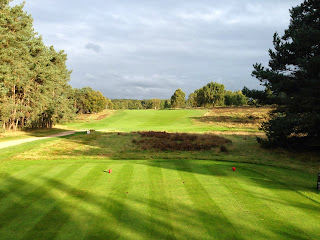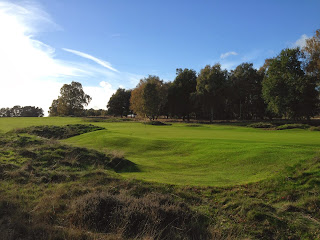Course Management
Course Manager’s report for October 2013
Fine Turf Management
The greens are currently being cut at 4.5mm with rolling taking place twice each week; as we move into November, the height will increase to 5mm. We have recently taken delivery of a new greens roller which will enable us to roll on both courses simultaneously if required now that we have two rollers. Throughout the year we have the valuable option to roll instead of mowing, whilst still maintaining the greens speed; over the long term, this will reduce stress on the turf and improve the quality of the sward. We aim to pedestrian mow as many times as possible during every week, as this gives us a much improved finish and increases pace dramatically; throughout the winter period, greens are only cut with pedestrian mowers.
Over-seeding success – As you have probably seen on the greens, the percentage of seed which has germinated and is now growing within the sward is excellent. The drill lines are very clear to see. The success of over-seeding is important in the future development of the sward and builds on the work already completed. Further, as a direct consequence, the ultimate goal of bent and fescue dominated greens is brought very much closer.
We have recently completed some heavy verti drain work on the new 11th green on Highgate. This work was discussed with Alistair Beggs (Agronomist) during his visit on the 7th October 2013. We have used 24mm tines to a depth of 300mm minimum to alleviate the compaction deep in the soil profile. These holes were then filled with top dressing. The initial signs are very good, but given the nature of the work, the greens will remain out of action for a significant period of time.
All of the greens will be verti drained with 12mm tines towards the end of this month. This will enable us to start the winter maintenance programme of monthly slit tining until the end of January 2014, after which we will move to using solid round 10mm tines through into the spring and on the same rotation.
Throughout the winter period, all greens and collars will receive a monthly application of chelated iron and seaweed in order to harden the turf and sustain and maintain a healthy turf throughout the winter period. The chelated iron also has a mild suppressant action on any fungal activity.
Tees
All tees are currently being cut with pedestrian mowers at 8mm twice a week. This significantly improves the presentation and quality of the surface. This height of cut will increase over the coming weeks to 10mm, which is our consistent, usual winter height. The tees are divoted twice a week alongside the regular general maintenance of emptying all litter bins and cleaning around the marker stones.
Aeration throughout the winter period forms a similar programme to that of the greens and will be undertaken and completed on a 3-4 week cycle basis.
Worm activity is a particular problem on some tees and in the past we have used chemical to combat the problem. However, this year we have tried a new product which is completely organic, and the first signs are promising. I will be monitoring the progress of this product over the winter period.
Over the coming weeks we will move tee balls onto the winter tee areas in order to give the main tee areas time to recover ready for next season. We will be completing some re-turfing and targeted renovation work on some of the more damaged tees.
Fairways
Over the last two seasons I have been especially pleased with the condition of the fairways, particularly in terms of the percentages of the finer grasses and the way in which they have held up through some extremes of weather. The work that has gone into these fairways over the last seven years can not and should not be underestimated, especially in terms of over-seeding, aeration and wetting agent application.
We are currently cutting fairways at 14mm as and when needed; at this time of year, one of our biggest problems and challenges is to get a clean cut as there is still growth that warrants and requires cutting. For example, inevitably, there are leaves and other debris on the surface which have to be cleared, whilst additionally the surface remains very wet; therefore the quality of cut is closely monitored in order that the clean cut is achieved.
Areas of weaker growth have been over-seeded and top dressed to improve sward composition.
Rough
We have recently been scarifying and cutting areas of the ecology rough which have become too dense and populated with the wrong type of grasses. By completing this work on a regular basis it encourages a more open sward that is dominated by the finer grasses and therefore makes ball retrieval easier. It also results in the maintenance of our ecology rough, which creates excellent definition to the courses.
The annual heather cutting and seed harvesting will begin during November; areas of heather are cut on a two year rotation. The harvested seed is used for heathland establishment and we also supply other golf courses with seed, as well as Natural England sites, which are undertaking heathland regeneration.
Over the last month we have been busy cutting down bramble areas within the woodland; over the last two years brambles have been really very aggressive in their growth habit so we have taken the opportunity to get on top of some of these areas by including their regular maintenance into the ongoing programme. In some of the more prominent areas we will be spraying the brambles with herbicide in the spring to reduce any new growth.
General
Kelvin Cowley is our new apprentice. He started with us in September and has settled in well. The search for a second apprentice has been a little slower to gain momentum, but we are conducting initial interviews next week (w/c 21st October 2013) with candidates sourced via the National Apprenticeships website; the Apprenticeship has also has been advertised in conjunction with Rodbaston College. I am anticipating that the second apprentice should be identified and appointed via these interviews and will therefore be in post during December.
I have also researched the viability of using a mechanic from a local machinery supplier. The role would be based on the mechanic working on-site on a weekly basis, to help with the all-important general machinery maintenance (this was discussed at a meeting held on 20th September). The need to maintain our existing fleet in prime condition is paramount to the standards we set on the courses. Machines and particularly cutting machines, have to be set-up correctly and available for the task every time that they required. Our mechanic currently works a three day week, but we are finding there is an increasing need for the greenkeeping team to get involved with machinery maintenance when our mechanic isn’t on-site, which has the knock-on effect of taking them away from there required duties. I have approached two of our suppliers and they have provided costings, based on the provision of a mechanic on an hourly basis and on a routine and frequency specified by me. The rate is £30 per hour, plus traveling expenses, so £240 per day, plus expenses. Initially I would like to recommend that we use this resource at a rate of four days per month, based on a 4-week month, so approximately 1 day per week. For the longer term I will look into other options for staffing that will continue to improve the provision of excellent maintenance of the machinery.
Jonathan Wood
Course Manager
Enville Golf Club
07977448149
jw@j-wood.co.uk











